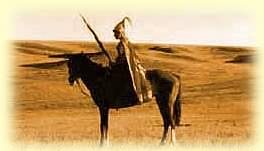The Kalmyks (a people closely related to all
the Oirats of Inner Asia as well as to the Mongols and the Buriats) originally
lived in Dzungaria (Sinkiang Province, China). After the breakdown
of the great Mongolian Empire, they were forced from their homeland and
they migrated westward. In the early seventeenth century they settled
on the steppes of the Lower Volga region of south Russia (around 1620s)
establishing a Kalmyk kingdom (khanate), north
of the Caspian Sea. Until the mid-eighteen century the Kalmyk kingdom enjoyed
virtual independence from the Russian empire. In 1771 the Kalmyks choose
to return to Dzungaria rather than submit to Russian imperial domination.
In doing so they left behind about 20% of their number, those who lived
at the west bank of the Volga river. For the next 150 years these who remained
managed to get along with Russian authorities. After 1803 they were administrated
by Russian "guardian of the Kalmyk people", continuing at the same time
to obey and respect their few remaining princes (noyons).  Until
the turn of the century they led predominantly nomadic way of life - they
used to raise horses, cattle, sheep, goats, and a few camels. Their
nomadism was of a classical pattern: an annual round of movement
from winter camp to spring, summer, and fall pasture, and return. The Kalmyk
home was a tent (called a yurt) made of felt on a lattice frame, readily
assembled and disassembled. Gradually, their way of life began to change.
Many Kalmyks began to settle on the land and become agricultiralists. Where
they have taken to agriculture, they have introduced fixed dwellings. Until
the turn of the century they led predominantly nomadic way of life - they
used to raise horses, cattle, sheep, goats, and a few camels. Their
nomadism was of a classical pattern: an annual round of movement
from winter camp to spring, summer, and fall pasture, and return. The Kalmyk
home was a tent (called a yurt) made of felt on a lattice frame, readily
assembled and disassembled. Gradually, their way of life began to change.
Many Kalmyks began to settle on the land and become agricultiralists. Where
they have taken to agriculture, they have introduced fixed dwellings.
During the Russian Revolution and the Civil War that followed, the majority of the Kalmyks sided with anti-Bolshevik armies. The defeat of these armies caused some of the Kalmyks to flee Russia, along with thousands of other people. After a brief sojourn in Turkey, they dispersed into Yugoslavia, Bulgaria, Czechoslovakia and France to set up new homes. |
|